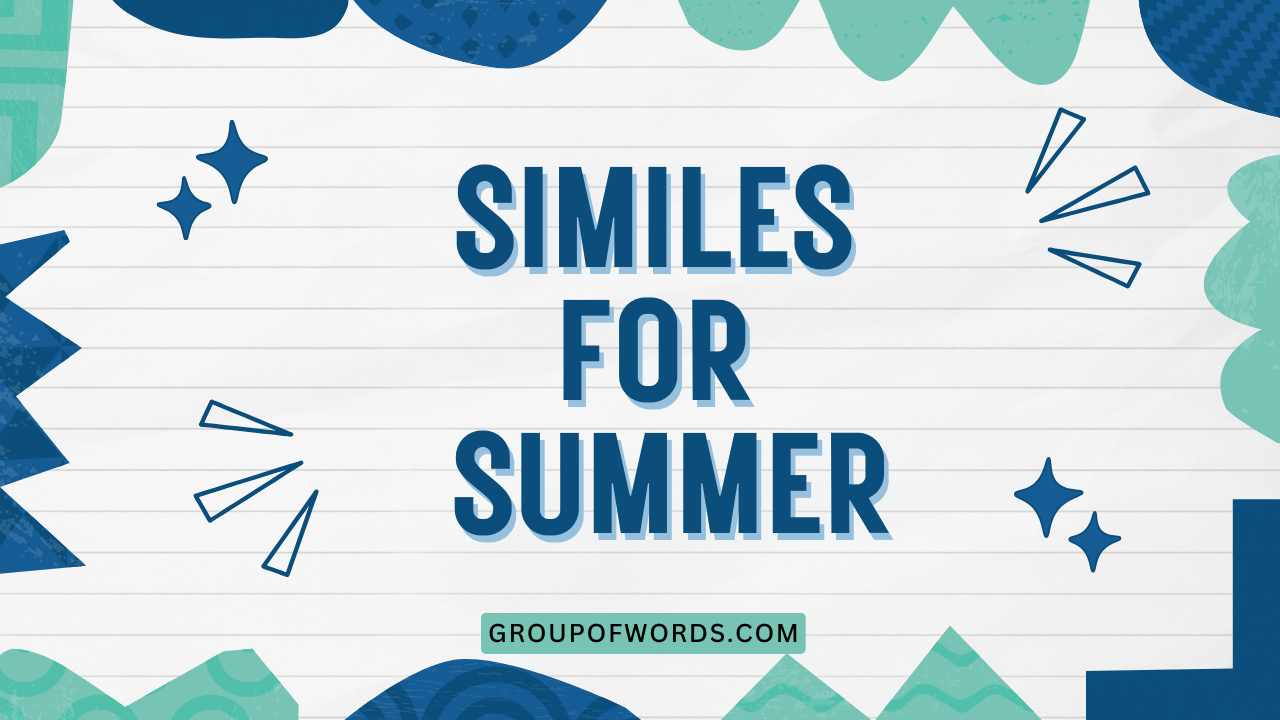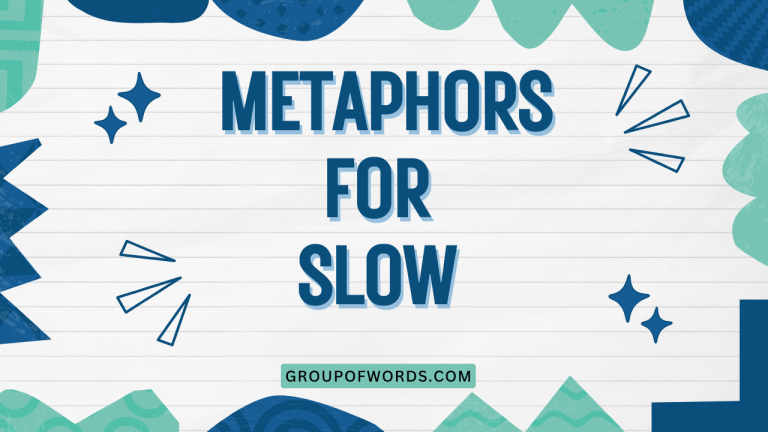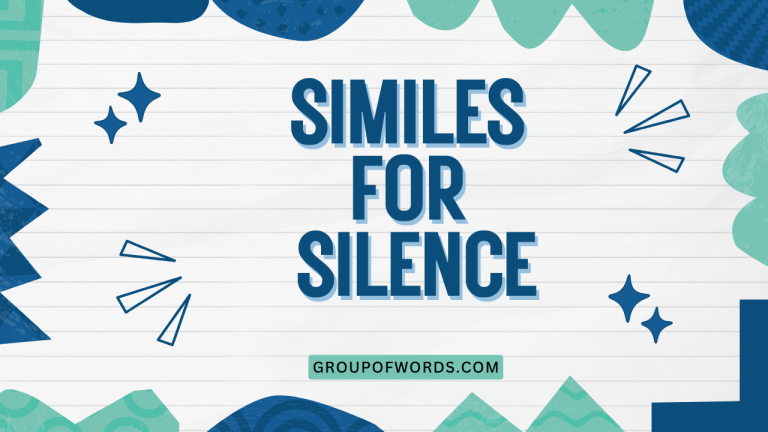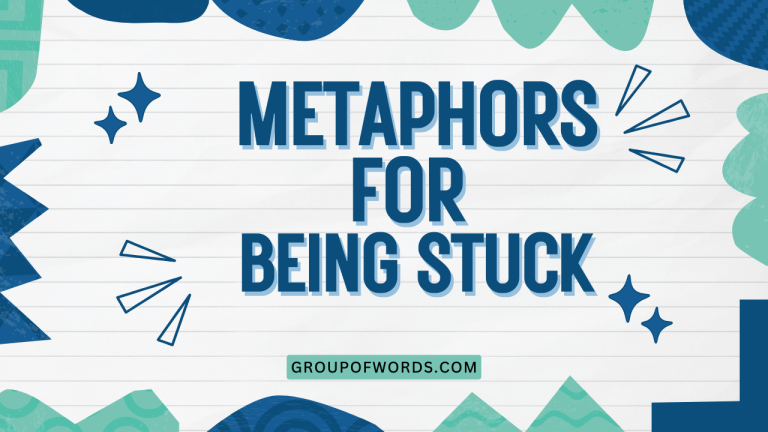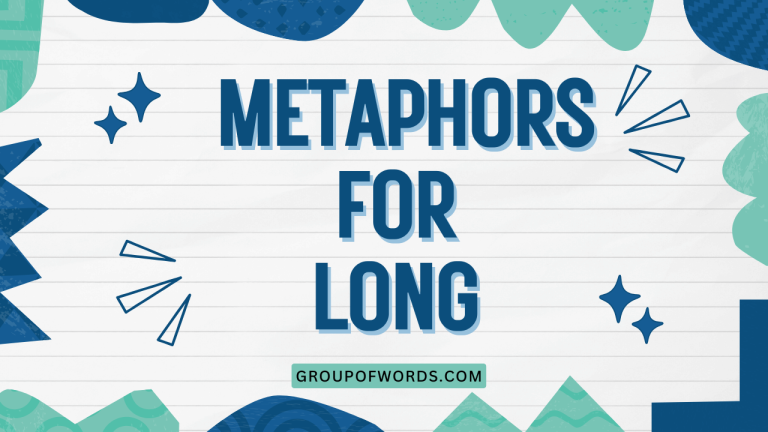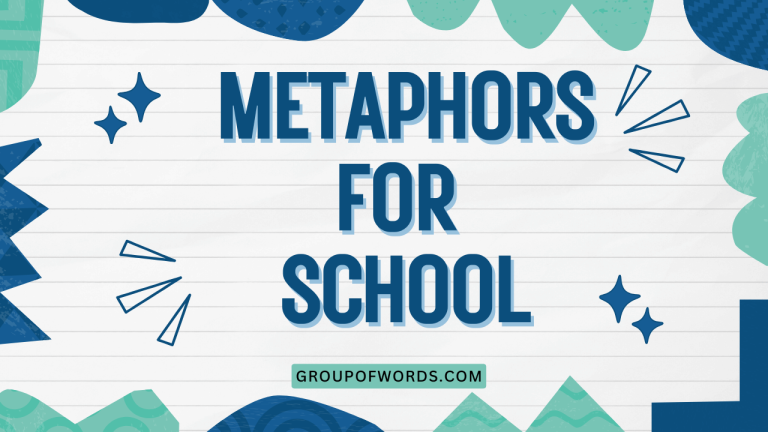Summer Similes: A Guide to Figurative Language
Summer, with its vibrant colors, intense heat, and leisurely pace, offers a rich tapestry of experiences. Similes, a powerful tool in the English language, allow us to paint vivid pictures and draw compelling comparisons to capture the essence of this season.
Understanding and using similes effectively can greatly enhance your writing and speaking skills, making your descriptions more engaging and memorable. This article provides a comprehensive guide to summer similes, exploring their structure, function, and usage, with numerous examples and exercises to help you master this figurative language technique.
Whether you’re a student, writer, or simply an English enthusiast, this guide will equip you with the knowledge and skills to use similes like a pro.
This guide is designed for English language learners of all levels, from beginners to advanced speakers. Whether you’re looking to improve your writing skills, enhance your vocabulary, or simply understand the nuances of figurative language, this article will provide you with the tools and knowledge you need to succeed.
By the end of this guide, you’ll be able to identify, understand, and use similes effectively in your own writing and speaking.
Table of Contents
- Definition of Similes
- Structural Breakdown of Similes
- Types of Similes
- Examples of Summer Similes
- Usage Rules for Similes
- Common Mistakes with Similes
- Practice Exercises
- Advanced Topics: Nuances of Similes
- Frequently Asked Questions
- Conclusion
Definition of Similes
A simile is a figure of speech that compares two unlike things using the words “like” or “as.” It’s a way of making a description more vivid and imaginative by drawing a connection between something familiar and something less so. Similes help readers or listeners understand a concept or image more clearly by relating it to something they already know.
In essence, a simile states that one thing resembles another in some way. This resemblance is often based on a shared quality or characteristic. For example, “The sun is like a giant spotlight” compares the sun to a spotlight, highlighting their shared characteristic of brightness and focused light.
Similes are different from metaphors, which directly equate two things without using “like” or “as.” A metaphor would say, “The sun is a giant spotlight,” implying that the sun is the spotlight, not just similar to it. Similes offer a more nuanced comparison, suggesting a resemblance rather than a complete identity.
Similes are often used in literature, poetry, and everyday conversation to add color and depth to language. They can be used to describe physical appearances, emotions, actions, and abstract concepts.
By using similes, writers and speakers can create more engaging and memorable experiences for their audience. The power of simile lies in its ability to evoke strong imagery and create a deeper understanding through comparison.
Structural Breakdown of Similes
A simile typically consists of three key components:
- The subject: This is the thing being described or compared.
- The comparison word: This is either “like” or “as,” which signals that a comparison is being made.
- The object of comparison: This is the thing the subject is being compared to.
The basic structure of a simile can be represented as follows:
[Subject] + [Comparison Word (like/as)] + [Object of Comparison]
Let’s break down an example:
“The summer air was like a warm blanket.”
- Subject: The summer air
- Comparison Word: like
- Object of Comparison: a warm blanket
This simile compares the summer air to a warm blanket, suggesting that the air feels comforting and enveloping. The comparison relies on the shared quality of warmth.
Another example:
“She was as radiant as the summer sun.”
- Subject: She
- Comparison Word: as…as
- Object of Comparison: the summer sun
This simile compares the woman’s radiance to the brightness of the summer sun, highlighting their shared characteristic of luminosity and beauty.
Similes can also be more complex, including descriptive adjectives or adverbs to enhance the comparison. For example:
“The lemonade was as sweet as freshly picked strawberries.”
Here, the simile not only compares the lemonade to strawberries but also specifies the quality of sweetness, making the comparison more precise.
Understanding the basic structure of a simile is crucial for both identifying and creating them effectively. By recognizing the subject, comparison word, and object of comparison, you can easily analyze and appreciate the nuances of this figurative language device.
Types of Similes
While all similes share the basic structure of comparing two unlike things using “like” or “as,” they can be categorized based on the type of comparison they make and the effect they create. Here are a few common types of similes:
Descriptive Similes
These similes focus on describing a physical attribute or quality of the subject. They aim to create a vivid image in the reader’s mind by comparing the subject to something with a similar characteristic.
Example: “The sand was as hot as fire.” (describes the temperature of the sand)
Emotional Similes
These similes express the emotional state or feelings of the subject. They compare the subject’s emotions to something that evokes a similar feeling.
Example: “He felt as light as a feather on the last day of school.” (describes a feeling of freedom and relief)
Action Similes
These similes describe the actions or behavior of the subject. They compare the subject’s actions to something that performs a similar action.
Example: “The children ran through the sprinklers like playful dolphins.” (describes the children’s energetic and joyful movements)
Abstract Similes
These similes compare abstract concepts or ideas. They help to clarify complex concepts by relating them to something more concrete or familiar.
Example: “Summer vacation felt like an endless dream.” (compares the feeling of summer vacation to the abstract concept of a dream)
Exaggerated Similes (Hyperbolic Similes)
These similes use exaggeration to emphasize a particular quality or characteristic. They often create a humorous or dramatic effect.
Example: “The sun was as bright as a thousand lightbulbs.” (exaggerates the brightness of the sun)
Understanding these different types of similes can help you to use them more effectively in your writing and speaking. By choosing the right type of simile, you can create a more precise and impactful comparison that resonates with your audience.
Examples of Summer Similes
Summer provides a wealth of inspiration for similes. The following sections offer numerous examples of similes related to various aspects of summer, categorized for clarity and ease of understanding.
Similes Describing Heat
The heat of summer is a common subject for similes. These examples illustrate different ways to describe the intensity and sensation of summer heat.
The following table provides a range of similes focusing on the summer heat. Each simile aims to capture the intensity and sensation of the high summer temperatures.
| Simile | Explanation |
|---|---|
| The sun beat down like a hammer on the roof. | Emphasizes the forceful and relentless nature of the sun’s heat. |
| The air was as thick as soup. | Describes the heavy, oppressive feeling of humid heat. |
| The asphalt shimmered like a mirage. | Captures the visual distortion caused by intense heat on the pavement. |
| Walking outside felt like stepping into an oven. | Highlights the intense, enclosed heat felt upon leaving an air-conditioned space. |
| The sand was as hot as fire. | Emphasizes the extreme heat of the sand on a sunny beach. |
| The heat radiated off the buildings like waves. | Describes the visible and palpable heat emanating from structures. |
| The day was as sweltering as a sauna. | Compares the day to the high-temperature, high-humidity environment of a sauna. |
| The air hung heavy, like a wet blanket. | Describes the heavy, oppressive feeling of humid heat. |
| The sun glared down like an angry eye. | Emphasizes the intense and almost malevolent feeling of the sun’s heat. |
| The heat was as stifling as a closed room. | Highlights the feeling of being trapped and suffocated by the heat. |
| Sweat trickled down my face like tiny rivers. | Describes the profuse sweating caused by the heat. |
| The sun felt like a giant magnifying glass. | Emphasizes the concentrated and intense heat of the sun. |
| The air crackled with heat like a desert. | Compares the dry, intense heat to the arid environment of a desert. |
| The heat was as relentless as a desert storm. | Highlights the unyielding and persistent nature of the heat. |
| The pavement burned like hot coals. | Emphasizes the intense heat of the pavement under the sun. |
| The sun’s rays pierced through the clouds like fiery arrows. | Describes the sharp, intense feeling of the sun’s rays. |
| The heat was as oppressive as a heavy weight. | Highlights the burdening and suffocating feeling of the heat. |
| The sun baked the earth like a giant oven. | Emphasizes the intense and all-encompassing heat of the sun. |
| The air shimmered and danced like flames. | Captures the visual distortion caused by intense heat in the air. |
| The heat was as dry as a bone. | Describes the arid and parched feeling of the heat. |
| The sun was like a furnace in the sky. | Compares the sun to a high-temperature furnace. |
| The heat felt as if a dragon was breathing on me. | Exaggerates the heat with a mythical comparison. |
| The day was as scorching as a pizza oven. | Compares the day to the high-temperature environment of a pizza oven. |
| The sun’s intensity was like a burning spotlight. | Emphasizes the concentrated and intense heat of the sun. |
| The city felt like a concrete jungle baking in the sun. | Highlights the urban heat island effect. |
Similes Describing Sunlight
Sunlight is another prominent feature of summer. These similes capture the brightness, warmth, and quality of summer sunlight.
The following table provides a variety of similes focusing on sunlight, capturing its brightness, warmth, and quality.
| Simile | Explanation |
|---|---|
| The sunlight streamed through the trees like golden honey. | Describes the warm, golden color and smooth flow of sunlight. |
| The sun shone as bright as a diamond. | Emphasizes the intense brilliance and sparkle of the sunlight. |
| The sunlight danced on the water like glittering jewels. | Captures the shimmering and sparkling effect of sunlight on water. |
| The sun’s rays felt like a warm embrace. | Highlights the comforting and pleasant sensation of sunlight on the skin. |
| The sunlight was as soft as a baby’s touch. | Emphasizes the gentle and delicate quality of the sunlight. |
| The sun looked like a giant orange in the sky. | Describes the color and shape of the sun at sunset or sunrise. |
| The sunlight filtered through the leaves like stained glass. | Captures the colorful and patterned effect of sunlight passing through foliage. |
| The sun’s glare was as sharp as a knife. | Emphasizes the intense and piercing quality of the sunlight. |
| The sunlight painted the landscape like a masterpiece. | Highlights the transformative and beautiful effect of sunlight on the scenery. |
| The sun’s light was as pure as gold. | Emphasizes the valuable and untainted quality of the sunlight. |
| The sunlight warmed my skin like a gentle fire. | Describes the comforting and warming sensation of sunlight. |
| The sun’s rays reached down like welcoming arms. | Highlights the inviting and comforting nature of sunlight. |
| The sunlight sparkled like fairy dust. | Captures the magical and enchanting quality of sunlight. |
| The sun was as radiant as a smile. | Emphasizes the cheerful and uplifting effect of sunlight. |
| The sunlight poured down like liquid gold. | Describes the rich, golden color and abundant flow of sunlight. |
| The sun’s light was as clear as crystal. | Emphasizes the clarity and purity of the sunlight. |
| The sunlight bathed the world in a warm glow like honey. | Describes the warm, golden color and encompassing effect of sunlight. |
| The sun’s rays tickled my face like feathers. | Highlights the light and gentle sensation of sunlight on the skin. |
| The sunlight shone through the window like a beacon. | Emphasizes the guiding and illuminating quality of sunlight. |
| The sun was as dazzling as a star. | Emphasizes the brilliance and captivating quality of the sun. |
| The sunlight felt as comforting as a mother’s hug. | Highlights the comforting effect of sunlight. |
| The sun looked like a giant eye watching over the world. | Describes the sun’s position and perceived oversight. |
| The sunlight was as invigorating as a morning breeze. | Emphasizes the revitalizing quality of the sunlight. |
| The sun’s light was as hopeful as a new dawn. | Emphasizes the positive and promising effect of sunlight. |
Similes Describing Summer Nature
Summer’s natural beauty is another rich source of similes. These examples capture the vibrant colors, sounds, and textures of summer landscapes.
The following table showcases similes that describe various aspects of summer nature, including colors, sounds, and textures.
| Simile | Explanation |
|---|---|
| The grass was as green as an emerald. | Emphasizes the vibrant color of the summer grass. |
| The flowers bloomed like a riot of color. | Describes the abundant and diverse colors of summer flowers. |
| The leaves rustled in the breeze like whispers. | Captures the soft, gentle sound of the wind blowing through the trees. |
| The lake shimmered like a sheet of glass. | Describes the smooth, reflective surface of the lake. |
| The crickets chirped like a chorus of tiny singers. | Highlights the rhythmic and harmonious sound of crickets at night. |
| The trees stood tall and proud like ancient guardians. | Describes the imposing presence and enduring quality of the trees. |
| The forest was as lush as a tropical jungle. | Emphasizes the dense and abundant vegetation of the forest. |
| The air smelled as sweet as honeysuckle. | Describes the fragrant and pleasant scent of summer air. |
| The clouds floated lazily like cotton balls in the sky. | Captures the slow, gentle movement and soft appearance of the clouds. |
| The stars twinkled like diamonds scattered across the night sky. | Emphasizes the bright, sparkling appearance of the stars. |
| The meadow stretched out like a green carpet. | Describes the vast and uniform appearance of the meadow. |
| The river flowed as smoothly as silk. | Emphasizes the gentle and uninterrupted flow of the river. |
| The birds sang as merrily as children at play. | Highlights the cheerful and joyful sound of birdsong. |
| The sunset glowed like a painting. | Describes the colorful and artistic appearance of the sunset. |
| The fireflies blinked like tiny stars on the ground. | Captures the intermittent and sparkling light of fireflies. |
| The garden was as vibrant as a rainbow. | Emphasizes the diverse and colorful elements of the garden. |
| The waves crashed against the shore like thunder. | Describes the loud and powerful sound of the waves. |
| The sand was as soft as powder. | Emphasizes the fine and delicate texture of the sand. |
| The forest was as silent as a sleeping giant. | Highlights the quiet and still atmosphere of the forest. |
| The mountains stood like silent sentinels. | Describes the imposing presence and watchful appearance of the mountains. |
| The flowers swayed in the breeze like dancers. | Captures the graceful and rhythmic movement of the flowers. |
| The water tasted as fresh as a mountain spring. | Emphasizes the pure and clean flavor of the water. |
| The night sky was as dark as velvet. | Emphasizes the deep and rich color of the night sky. |
| The moon shone like a silver coin. | Describes the color and shape of the moon. |
| The tall grass rippled in the wind like ocean waves. | Captures the movement of the tall grass. |
Similes Describing Summer Activities
Summer is a time for outdoor activities and leisurely pursuits. These similes capture the joy, energy, and relaxation associated with these activities.
This table provides similes that describe the joy, energy, and relaxation associated with summer activities.
| Simile | Explanation |
|---|---|
| Swimming felt like flying underwater. | Describes the sensation of weightlessness and freedom while swimming. |
| Eating ice cream was like tasting a cloud of sweetness. | Emphasizes the light, sweet flavor and texture of ice cream. |
| Playing in the park was like entering a world of adventure. | Highlights the excitement and imaginative play associated with parks. |
| Riding a bike felt like gliding on air. | Describes the smooth, effortless sensation of riding a bike. |
| Camping under the stars was like sleeping in a planetarium. | Captures the immersive and awe-inspiring experience of stargazing. |
| Having a picnic was like celebrating life in the sunshine. | Emphasizes the joyful and celebratory atmosphere of a picnic. |
| Reading a book in a hammock was as relaxing as floating on a cloud. | Highlights the peaceful and carefree feeling of reading in a hammock. |
| Grilling food smelled as enticing as a gourmet restaurant. | Describes the appealing and mouthwatering scent of grilled food. |
| Watching fireworks was like witnessing a symphony of light. | Captures the dazzling and coordinated display of fireworks. |
| Going to the beach was like escaping to paradise. | Emphasizes the relaxing and idyllic nature of a beach vacation. |
| Playing beach volleyball was as energizing as a shot of espresso. | Highlights the stimulating and invigorating effect of playing beach volleyball. |
| Hiking in the mountains felt like conquering the world. | Describes the sense of accomplishment and empowerment while hiking. |
| Catching fireflies was like capturing stars in a jar. | Captures the whimsical and magical feeling of catching fireflies. |
| Attending a summer concert was like being swept away by the music. | Emphasizes the immersive and emotional experience of live music. |
| Building sandcastles was as creative as sculpting art. | Highlights the imaginative and artistic aspect of building sandcastles. |
| Having a water balloon fight was as refreshing as a cold shower. | Describes the cooling and invigorating sensation of a water balloon fight. |
| Going to a baseball game was like stepping into a classic American movie. | Emphasizes the traditional and nostalgic atmosphere of a baseball game. |
| Watching a sunset was as peaceful as meditation. | Highlights the calming and contemplative effect of watching a sunset. |
| Having a bonfire was like gathering around a warm, friendly heart. | Emphasizes the communal and comforting feeling of a bonfire. |
| Eating watermelon was as refreshing as a cool rain on a hot day. | Describes the thirst-quenching and revitalizing effect of eating watermelon. |
Similes Describing Summer Feelings
Summer evokes a range of emotions, from joy and excitement to relaxation and nostalgia. These similes capture the essence of these summer feelings.
The following table presents similes that describe the range of emotions evoked by summer, from joy and excitement to relaxation and nostalgia.
| Simile | Explanation |
|---|---|
| Summer vacation felt like an endless dream. | Emphasizes the extended and surreal feeling of summer vacation. |
| The feeling of summer was as light as a feather. | Describes the carefree and unburdened feeling of summer. |
| Summer memories were as sweet as honey. | Highlights the pleasant and cherished nature of summer memories. |
| The joy of summer was as bright as the sun. | Emphasizes the intense and radiant happiness of summer. |
| Summer love felt like a fairytale. | Captures the romantic and magical quality of summer romances. |
| The anticipation of summer was as exciting as Christmas morning. | Highlights the eager and enthusiastic feeling of awaiting summer. |
| The relaxation of summer was as deep as the ocean. | Emphasizes the profound and immersive feeling of summer relaxation. |
| The nostalgia of summer was as warm as a familiar embrace. | Describes the comforting and sentimental feeling of reminiscing about summer. |
| The freedom of summer was like having wings. | Emphasizes the liberating and unconstrained feeling of summer. |
| The energy of summer was as boundless as the sky. | Highlights the limitless and invigorating vitality of summer. |
| The laughter of summer was as contagious as a happy song. | Describes the uplifting and shared joy of summer laughter. |
| The peace of summer was as calming as a gentle breeze. | Emphasizes the soothing and tranquil feeling of summer peace. |
| The adventure of summer felt like exploring a new world. | Captures the exciting and discovery-filled nature of summer adventures. |
| The happiness of summer was as radiant as a sunflower. | Highlights the bright and cheerful feeling of summer happiness. |
| The spirit of summer was as carefree as a child’s laughter. | Emphasizes the lighthearted and innocent feeling of summer spirit. |
| The magic of summer felt like a dream come true. | Captures the enchanting and wish-fulfilling quality of summer. |
| The warmth of summer was as comforting as a cozy blanket. | Describes the soothing and secure feeling of summer warmth. |
| The memories of summer shone as brightly as stars. | Emphasizes the vivid and unforgettable nature of summer memories. |
| The beauty of summer was as breathtaking as a masterpiece. | Highlights the stunning and awe-inspiring nature of summer beauty. |
| The essence of summer was as sweet as a ripe fruit. | Emphasizes the delightful and satisfying quality of summer’s essence. |
Usage Rules for Similes
Using similes effectively involves understanding a few key rules:
- Ensure a clear comparison: The connection between the subject and the object of comparison should be easily understandable. The reader should be able to grasp the shared quality that links the two.
- Use “like” or “as” correctly: Remember that similes use “like” or “as” to make the comparison. Avoid confusing similes with metaphors, which directly equate two things without these words.
- Avoid clichés: While familiar similes can be effective, overuse can make your writing seem unoriginal. Try to create fresh and imaginative comparisons.
- Consider the context: The appropriateness of a simile depends on the context of your writing or speaking. Choose similes that are relevant to the topic and audience.
- Be specific: The more specific your comparison, the more vivid and impactful it will be. Use descriptive adjectives or adverbs to enhance the simile.
Example of a clear comparison:
Correct: “The ocean was as blue as the summer sky.” (The shared quality is blueness.)
Incorrect: “The ocean was like a hamburger.” (There is no clear or logical connection.)
Example of avoiding clichés:
Cliché: “He was as brave as a lion.”
Improved: “He faced the challenge as bravely as a knight entering battle.”
Example of being specific:
Vague: “The day was like summer.”
Specific: “The day was as warm and sunny as a perfect summer afternoon.”
Common Mistakes with Similes
Even experienced writers sometimes make mistakes when using similes. Here are some common errors to avoid:
- Confusing similes with metaphors: As mentioned earlier, similes use “like” or “as,” while metaphors do not.
- Creating illogical comparisons: The subject and object of comparison should have a clear and logical connection.
- Using mixed metaphors and similes: Avoid combining metaphors and similes in a way that creates a confusing or nonsensical image.
- Overusing similes: Too many similes can clutter your writing and detract from its impact. Use them sparingly and strategically.
- Choosing inappropriate similes: The simile should be appropriate for the tone and context of your writing or speaking.
Here are some examples of common mistakes and corrections:
| Incorrect | Correct | Explanation |
|---|---|---|
| “The summer was a warm blanket.” (Metaphor used as a simile) | “The summer was like a warm blanket.” (Correct simile) | A simile requires “like” or “as.” |
| “The sun was as blue as a lemon.” (Illogical comparison) | “The sun was as bright as a lemon.” (Logical comparison) | The subject and object must share a relevant quality. |
| “He was a lion in sheep’s clothing, like a lamb.” (Mixed metaphor and simile) | “He was like a wolf in sheep’s clothing.” (Consistent simile) | Avoid mixing different figurative language devices. |
Practice Exercises
Test your understanding of similes with these practice exercises.
Exercise 1: Identifying Similes
Identify the similes in the following sentences.
| Question | Answer |
|---|---|
| 1. The summer breeze was as gentle as a caress. | as gentle as a caress |
| 2. The lake was a mirror reflecting the sky. | (No simile – this is a metaphor) |
| 3. The children splashed in the pool like playful otters. | like playful otters |
| 4. The heat shimmered like a mirage. | like a mirage |
| 5. She is the sun in my sky. | (No simile – this is a metaphor) |
| 6. The lemonade was as sweet as candy. | as sweet as candy |
| 7. The stars twinkled like diamonds. | like diamonds |
| 8. His laughter was music to my ears. | (No simile – this is a metaphor) |
| 9. The night was as dark as velvet. | as dark as velvet |
| 10. The leaves danced in the wind like ballerinas. | like ballerinas |
Exercise 2: Completing Similes
Complete the following similes with appropriate endings.
| Question | Answer |
|---|---|
| 1. The summer days are as long as __________. | …a journey across the world. |
| 2. The ice cream was as cold as __________. | …an arctic breeze. |
| 3. The beach was as crowded as __________. | …a marketplace. |
| 4. The sun shone as brightly as __________. | …a lighthouse. |
| 5. The night air was as still as __________. | …a statue. |
| 6. The watermelon was as juicy as __________. | …a waterfall. |
| 7. The children were as excited as __________. | …kids on Christmas morning. |
| 8. The party was as lively as __________. | …a carnival. |
| 9. The sand was as smooth as __________. | …silk. |
| 10. The clouds were as white as __________. | …snow. |
Exercise 3: Creating Similes
Create your own similes based on the following prompts.
| Prompt | Possible Answer |
|---|---|
| 1. Describe the sound of summer rain. | The summer rain sounded like a gentle drumbeat on the roof. |
| 2. Describe the feeling of swimming in the ocean. | Swimming in the ocean felt like being cradled by the waves. |
| 3. Describe the taste of a ripe strawberry. | A ripe strawberry tasted as sweet as sunshine. |
| 4. Describe the smell of sunscreen. | The smell of sunscreen was like a promise of summer fun. |
| 5. Describe the feeling of a hot summer day. | A hot summer day feels like being wrapped in a warm blanket. |
Advanced Topics: Nuances of Similes
Beyond the basic rules and examples, there are more subtle aspects of similes that can enhance your writing. These include:
- Subtlety: Similes don’t always have to be overt. A well-crafted simile can be subtle, inviting the reader to make the connection without explicitly stating it.
- Originality: Strive for originality in your similes. Avoid clichés and try to find fresh, unexpected comparisons that will surprise and delight your readers.
- Sensory Detail: Engage the senses by using similes that evoke sight, sound, smell, taste, and touch. This will make your writing more vivid and immersive.
- Emotional Resonance: Use similes to tap into the emotions of your readers. A well-chosen simile can evoke a strong emotional response, making your writing more impactful.
- Cultural Context: Be aware of the cultural context of your similes. A simile that is effective in one culture may not be in another.
Example of a subtle simile:
“The afternoon sun bled across the sky.” (Implies the sun’s color is like blood without explicitly stating “as red as blood.”)
Example of a simile with strong sensory detail:
“The scent of the barbecue drifted through the air, as smoky and savory as a campfire under the stars.” (Engages the sense of smell and sight.)
Frequently Asked Questions
What is the difference between a simile and a metaphor?
A simile compares two things using “like” or “as,” while a metaphor directly equates two things without using those words. Similes suggest a resemblance, while metaphors imply a complete identity.
Why are similes useful in writing?
Similes make descriptions more vivid and imaginative, helping readers understand concepts more clearly by relating them to something familiar. They add color, depth, and emotional resonance to your writing.
How can I avoid using clichés in my similes?
Strive for originality by finding fresh, unexpected comparisons. Think about the specific qualities you want to emphasize and brainstorm unique ways to express them.
Can I use similes in formal writing?
Yes, but use them sparingly and strategically. Choose similes that are appropriate for the tone and context of your writing, and avoid overly informal or colloquial comparisons.
What if I can’t think of a good simile?
Don’t force it. Sometimes the best approach is to describe something directly without using figurative language.
You can also try brainstorming a list of related words or images and see if any spark an idea for a simile.
Conclusion
Similes are a powerful tool for enhancing your writing and speaking skills, especially when describing the vibrant and evocative season of summer. By understanding the structure, types, and usage rules of similes, you can create vivid and memorable comparisons that engage your audience and bring your descriptions to life.
Remember to strive for originality, consider the context, and avoid common mistakes. With practice and attention to detail, you can master the art of using similes and unlock the full potential of this versatile figurative language device.
So go forth and paint the world with your words, one simile at a time!
